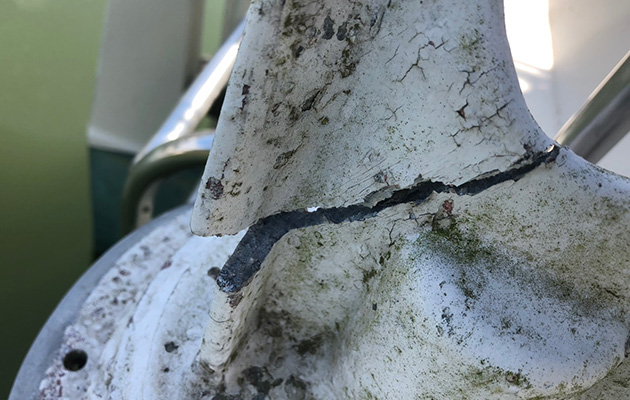Dimming lights point Jonty Pearce towards battery problems
Apologies for the adulterated Lewis Carroll quote, but, rather like his poem The Walrus and the Carpenter, when sailing we frequently never know what abstract issue will crop up next.
Carol and I enjoyed a week’s break aboard Aurial as August turned into September.
It was a treat to finally be cruising again after all our works and reparation, though our first port of call was Sandy Haven off the Milford Haven waterway in order to dry out and scrape the propeller clear of barnacles.
This hidden creek winds its way between wooded shores for a mile and a quarter, drying to firm flat sand above the stepping stones that give foot passage over its stream at low tide.
Our usual anchoring spot was occupied by another Southerly on a new mooring, but there is plenty of space and I picked a nice level area (more by luck than judgement) for Aurial to settle onto.
Once high and dry, I gave her bottom a quick brush off and cleaned the propeller.
In fact, the Trilux antifoul coating I had applied last August in the Isles of Scilly had done its job well, but there was still enough encrustation to lower her speed and make the engine labour slightly.
I repainted the blades with Trilux, and when we left Sandy Haven Aurial’s smooth acceleration endorsed her pleasure in my endeavours – it is surprising how even a few barnacles can impair propulsion.
We sailed out to Skomer for the night, but when Carol turned her reading light on there was only a dim glow. I checked the voltage – 10.5V – and reluctantly ran the engine for an hour to recharge.
The increased voltage made the bulbs blaze like Blackpool Illuminations, and while Carol happily turned her pages I ruminated about Aurial’s battery bank.
Continues below…
Jonty Pearce: The first sail of the season
During our Friday evening three hour drive to Aurial, we reassured ourselves that Saturday would dawn still and sunny for…
Jonty Pearce: The Good, the Bad, and the Ugly
A fractured davit causes problems for Jonty Pearce as he prepares Aurial for cruising
We tend to leave the fridge on permanently, and though the chartplotter and associated instruments gulp some juice, I was still surprised that the voltage had dropped so much while the battery monitor suggested that the capacity was only down to 75%.
This had happened before; at that time capacity testing had proved my three Lifeline AGM 105AH batteries had reduced to a mere 12AH of storage each.
My shorepower charger does not have a de-sulphation cycle, and no doubt the battery plates had fallen prey to deposit formation that had robbed their power reserves.
A quick search through my records showed that I had replaced those batteries with ‘calcium technology’ cells in 2012. The guarantee was for 4 years, so I was sympathetic to their plight at over 6 years; the more expensive Lifeline batteries had failed at 7 years.
I resolved to renew them with the same brand, though probably in the spring as we only plan weekend use over the winter.
At the end of our break we returned to our berth and plugged in the shorepower. As a man, my default position is to consider myself the expert in all things mechanical.
I have learnt, however, to take notice of Carol’s powers of observation; she realised that the battery charger was still whirring away after some six hours, and asked if this was normal.
In fact, she told me emphatically that this was not normal; I could only agree. Add to this the fact that the gas alarm had triggered twice during the evening (both times after I had clumsily spilt wine nearby), and I twigged that all might not be well on the battery front – could they be gassing?
It being late, we opened the hatch, disconnected the shorepower, turned off the batteries, and turned in ourselves.
I had assumed that the house batteries were the culprit, and suspected a failed cell. The charger still ran non-stop on reconnection in the morning, but when I checked each of the house batteries they were cool with matching voltages.
It was at this point that I spotted the bulging and hot start battery. The charger was already off, so I disconnected the negative terminal to isolate the battery and let it cool.
This battery was 4 years old; the previous one had lasted 9 years so I telephoned the supplier to ask if it was acceptable for a top quality Red Flash battery to behave this way.
I wasn’t really reassured by the ‘it can happen’ sort of answer I received, but accepted that a cell can fail causing battery malfunction.
I gingerly removed the now cool battery for recycling, and ordered a replacement.
The bulging battery shook me, so I am now busy researching battery temperature probes for my alternator smart charger, and expensive shorepower chargers with battery temperature modulation and a de-sulphation cycle.
The Southampton Boat Show approaches; I shall be asking questions and recharging my wallet!






